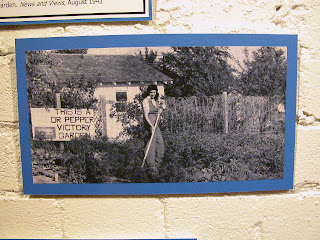Eye Catching Case
Cases and cases, all containing special exhibits, the museum is full of them and what museum isn’t? The question is which ones stand out? Which ones are filled with the most interesting information? This is the question I was asked, and I found my answer on the first floor in the back room of the museum.
This case displays countless Dr Pepper containers spanning a wide variety of time from the 1890s to present showing the development of Dr Pepper containers over time. There are tons of examples of early containers including the rare and unique. It is truly fascinating.

When you first approach the case you are greeted by a rotating display of aged syrup jugs and dispensers. Did you know when this museum building was used as an early bottling plant they used to make the syrup upstairs on the second floor? The floors up there are still constructed with a rise so at the end of the day employees could just hose down the floors and the syrupy water would just drain into the surrounding gutter system.

Once you get past the rotating display, the case opens up to numerous examples of Dr Pepper bottling. The earliest bottles had paper labels that were hand applied with a flour paste. These paper labels deteriorated quickly moving manufacturers to try something else. Embossed bottles came into production and were typical glass bottles with out a label but rather adorned with raised print. Once these bottles began rubbing against and damaging each other on the conveyor belt manufactures switched to the debossed or engraved style of bottles. All of which are on display within this particular case.

Also on display are glass bottles introduced around the 1950s with applied color labels. These bottles have a permanent colored label that is not painted on, but made of colored glass and fused on to the bottle using fire. Following the glass bottles the display moves into the canned soft drink area. The first beverage cans resemble thick soup cans with cone tops. Problems with these cans like leaking, and difficulty with flavor absorption and stacking lead to the development of flat top cans. On display in the case is a wide variety of these cans whether they have cone tops or flat tops with punch in type tops, pull off tabs or stay on tabs (reducing the amount of litter).

In the 1970s plastic bottles were introduced and pulled from the market seven years later due to the instability of the plastic. Finally, polyester appeared as the material of choice and plastic bottles of Dr Pepper were made and still are in sizes of up to three liters. Several non returnable bottles are on display; these bottles are just made with a lighter weight glass and have interesting designs usually commemorating a special event, organization or anniversary.

The display concludes with modern day packaging and describes multi- unit packaging to be a significant influence in sales growth of the soft drink industry.

This case displays rare examples of Dr Pepper bottling, like the blue can of Diet Dr Pepper that always catches my eye. There is also a container that looks like a plastic Dr Pepper cup with a flat aluminum lid and a permanent tab. You can also see glass long-neck bottles with plastic screw on lids, 16.9 oz cans of Pepper Free (a drink containing less sugar and caffeine) with plastic flip tops and a 6.3 oz “baby” can of Diet Dr Pepper.
This exhibit is full of interesting information regarding how Dr Pepper bottling game to be what it is today. I love looking at all the different designs on each bottle or can and seeing how they’ve progressed to be the way they currently are. This is the case that always catches my eye and who knows, it could catch yours too.













